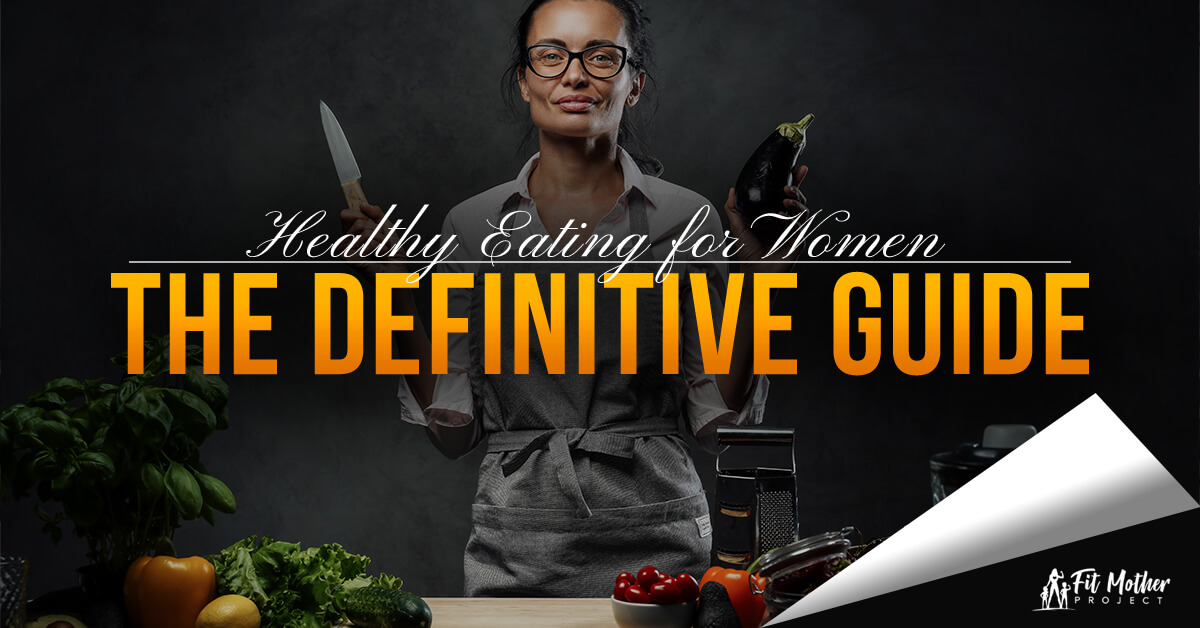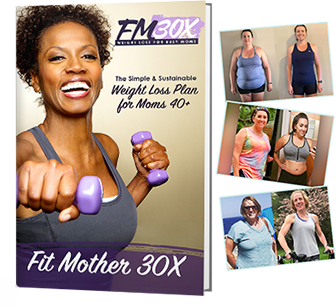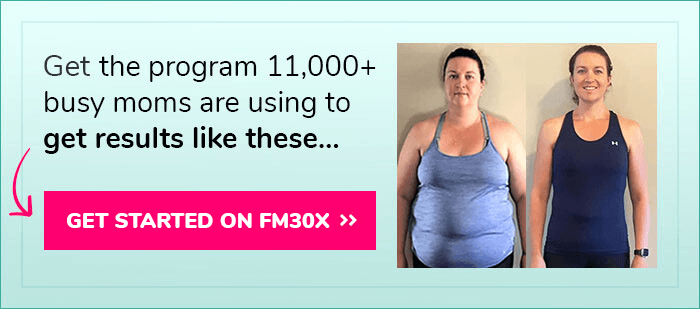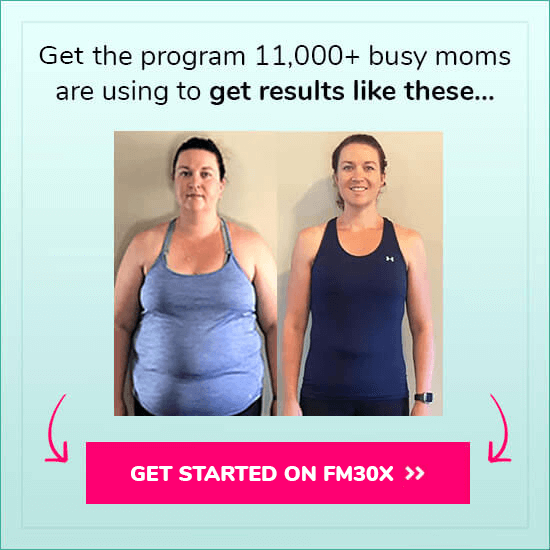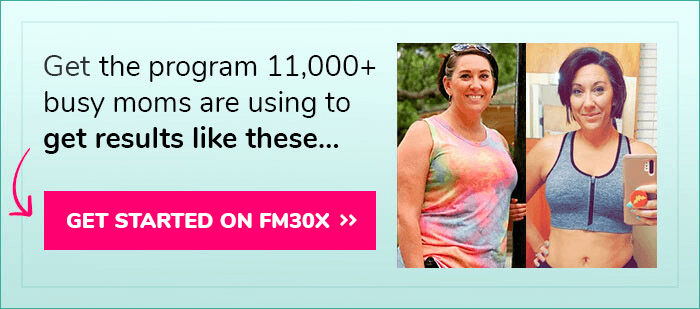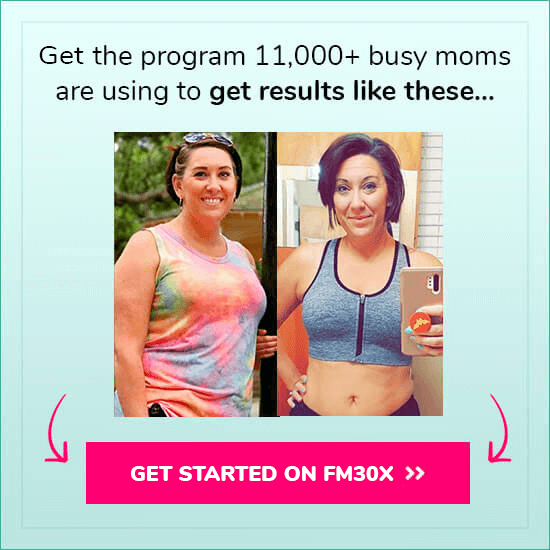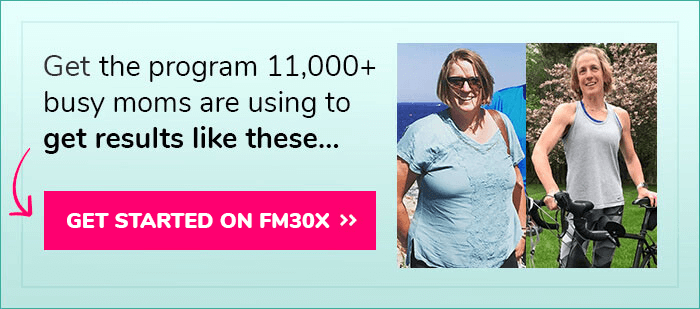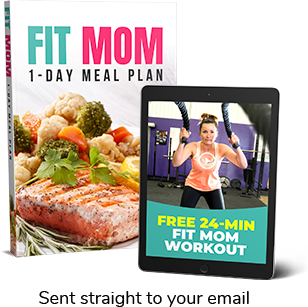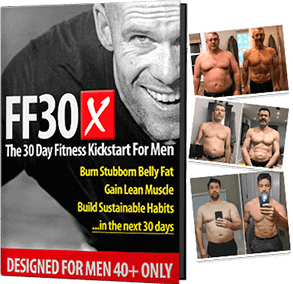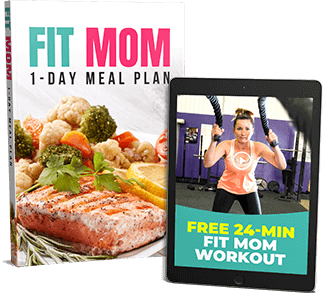Although it may not always seem that way, healthy eating for women is simple with the right knowledge and tools in place.
You just have to make some simple diet, exercise, and other lifestyle changes.
And don't be too hard on yourself!
Healthy eating for women is one of the best ways to control your calorie intake, maintain a healthy weight, and reduce your risk of debilitating chronic diseases.
Use our definitive guide to healthy eating for women to make good choices and achieve exceptional health and wellness!
We know how to help you reach all your health and fitness goals. But don't take our word for it. Read these real stories from real women!
Fit Mother Project is the first sustainable health & weight loss program designed exclusively for busy mothers just like you... FM30X is the first sustainable weight loss program designed exclusively for *busy* mothers like you... JOIN OUR fit
mother
PROGRAM (FM30X)JOIN OUR FIT MOTHER 30X PROGRAM
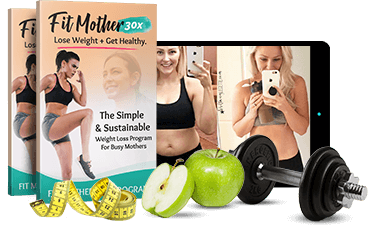
Nutritional Needs for Women
Women have unique nutritional needs. Knowing more about them can guide you along your journey toward better health, strengthen you immune system, and give you a boost of energy.
Calorie Requirements for Women
Women often require fewer calories than men. However, your actual calorie needs vary based on your size, metabolism, muscle mass/fat ratio, and your physical activity level.
The Dietary Guidelines for Americans recommend the following general calorie guidelines for healthy weight management in women:
- Ages 19-25: 2,000-2,400 calories
- Ages 26-30: 1,800-2,400 calories
- Ages 31-50: 1,800-2,200 calories
- Ages 51-60: 1,600-2,200 calories
- Ages 61 and older: 1,600-2,000 calories
These recommendations are general guidelines for most healthy women, but everybody is different with unique calorie needs.
If you have a lot of muscle mass, a fast metabolism, or you're very physically active, your calorie needs may be higher than 2,400 calories per day.
If your goal is weight loss, the National Heart, Lung, and Blood Institute (NHLBI) suggests women need about 1,200-1,500 calories per day to lose weight at an effective, safe pace of 1-2 pounds per week.
Your personalized weight-loss calorie needs might be more or less than this depending on your body composition, size, and weight loss goals.
Reducing your current energy intake by 500-1,000 calories daily can help you lose about 1-2 pounds per week. If you have a lot of weight to lose, your doctor might say it's okay to lose up to 5 pounds per week.
However, slow and gradual weight loss often gives you the best chance of maintaining your new healthy weight for a lifetime.
Macronutrient Needs
Macronutrient needs, or the number of carbohydrates, protein, and dietary fat you need daily, depend on your calorie requirements.
The Food and Nutrition Board recommends the following minimum daily macronutrient needs for women:
- Carbohydrates: 130 grams, or 45-65% of your calorie intake
- Fiber: 21-26 grams per day for women
- Protein: 46 grams, or 10-35% of your calorie intake
- Fat: 20-35% of your total calorie needs
- EPA plus DHA: at least 500 milligrams per day
If you're pregnant or nursing, your macronutrient requirements increase to at least 71 grams of protein, 175-210 grams of carbohydrates, and 28-29 grams of fiber daily.
Lists containing foods rich in carbohydrates, protein, and dietary fat are as follows:
Carbohydrate-Rich Foods (15 g of carbs per serving)
Foods that contain approximately 15 grams of carbohydrates per serving include oatmeal, whole-grain bread, whole-grain cereal, brown rice, wild rice, quinoa, and whole-grain pasta.
Other higher-carb options include fruit, milk, yogurt, plant yogurt, plain kefir, sweet potatoes, peas, corn, black beans, lentils, and other legumes.
Lower-Carb Foods (5 grams of carbs per serving)
Foods containing about 5 grams of carbohydrates (or less in some cases) per serving include lettuce, spinach, kale, other leafy greens, tomatoes, cucumbers, bell peppers, mushrooms, celery, carrots, asparagus, zucchini, broccoli, cauliflower, onions, and green beans.
Additional lower-carb options are Greek yogurt, plant milk, almonds, cashews, pistachios, peanuts, walnuts, sunflower seeds, pumpkin seeds, other nuts and seeds, and nut and seed butters.
What are the worst carbs to eat? Here are the most important carbs to avoid for weight loss!
Protein-Rich Foods
Healthy protein-rich foods include lean organic meat, chicken, turkey, duck, fish, shrimp, scallops, crab, other types of seafood, eggs, tofu, and seitan.
Additional sources of protein include nuts, seeds, nut butter, milk, yogurt, kefir, cottage cheese, cheese, peas, beans, lentils, and other legumes.
Protein powder, protein shakes, and protein bars are also excellent sources of protein.
A 3-ounce portion of chicken, fish, meat, or meat substitute can provide up to 20-25 grams of protein. One large egg contains 6 grams of protein.
A container of Greek yogurt provides about 18 grams of protein and 1 cup of cottage cheese contains about 25 grams. A cup of milk or soy milk provides about 8 grams of protein.
Cheese, nuts, seeds, nut butter, and legumes contain about 7 grams of protein per serving.
How much protein do we need per day? Calculate your daily protein intake!
Micronutrient Requirements
Micronutrient (vitamin and mineral) needs for healthy women are as follows:
Vitamins
- Vitamin A: 700 micrograms per day
- Vitamin C: 75 milligrams per day
- Vitamin D: 15-20 micrograms per day
- Vitamin E: 15 milligrams per day
- Vitamin K: 90 micrograms per day
- Thiamin: 1.1 milligrams per day
- Riboflavin: 1.1 milligrams per day
- Niacin: 14 milligrams per day
- Vitamin B6: 1.3-1.5 milligrams per day
- Folate: 400 micrograms per day
- Vitamin B12: 2.4 micrograms per day
- Pantothenic acid: 5 milligrams per day
- Biotin: 30 micrograms per day
- Choline: 425 milligrams per day
Minerals
- Calcium: 1,000-1,200 milligrams per day
- Chromium: 20-25 micrograms per day
- Copper: 900 micrograms per day
- Fluoride: 3 milligrams per day
- Iodine: 150 micrograms per day
- Iron: 8-18 milligrams per day
- Magnesium: 310-320 milligrams per day
- Manganese: 1.8 milligrams per day
- Molybdenum: 45 micrograms per day
- Phosphorous: 700 milligrams per day
- Selenium: 55 micrograms per day
- Zinc: 8 milligrams per day
- Potassium: 2,600 milligrams per day
- Sodium: 1,500 milligrams per day
- Chloride: 1.8-2.3 grams per day
If you're pregnant or breastfeeding, your micronutrient needs are higher.
Because of blood losses associated with menstruation, iron requirements for women of childbearing age are significantly higher than in women over 50.
Eating a well-balanced diet and taking a multivitamin supplement designed for women is the best way to meet your body's micronutrient requirements.
We explain basic nutrition for beginners, giving you 4 actionable ways to eat healthier!
Fluid Needs
Drinking plenty of water and other fluids is one of the best ways to keep energy levels high and reduce your risk of unwanted weight gain.
According to the Food and Nutrition Board, women need 2.7 liters (about 12 cups ) of fluid daily to maintain exceptional health.
Pregnant women need 3 liters (13 cups) and breastfeeding women often require 3.8 liters (16 cups) per day.
Individual fluid needs can vary.
You might need extra fluid in very hot weather or if you lose large amounts of fluid through sweating.
To meet your body's daily fluid requirements, consume plenty of water, coffee, tea, milk, plant milk, or broth-based soups.
Aim to drink at least 2 cups of water when you wake up in the morning and consume 2 cups of water before meals if your goal is weight loss.
Track your water intake throughout the day to ensure you meet daily fluid goals.
Learn the secret to drinking more water and having better hydration!
How to Plan Healthy Meals for Women
There are a few simple strategies you can use to plan out meals for healthy eating for women.
Perfect Plate Method
The perfect plate method is a simple way to portion foods and get the nutrients your body requires.
Simply fill your plate the following way during meals:
- Fill one-half of your plate with non-starchy (lower-carb) vegetables
- Fill one-fourth of each plate with protein foods
- Fill one-fourth of your plate with fiber-rich starches
- Mix in healthy fats at each meal
- Consume three servings of dairy foods or plant-based alternatives (milk, plant milk, etc.) per day
- Eat 1-2 servings of fruit daily
USDA Method
Your personalized USDA meal plan depends on your daily calorie requirements.
Use the Dietary Guidelines for Americans as a reference to plan well-balanced menus:
1,200-Calorie USDA Plan
- Fruits: 1 cups
- Vegetables: 1 1/2 cups
- Grains: 4 ounces
- Protein Foods: 3 ounces
- Dairy Foods: 2 1/2 cups
- Oils (healthy fats): 4 teaspoons
1,600-Calorie USDA Plan
- Fruits: 1 1/2 cups
- Vegetables: 2 cups
- Grains: 5 ounces
- Protein Foods: 5 ounces
- Dairy Foods: 3 cups
- Oils (healthy fats): 5 teaspoons
2,000-Calorie USDA Plan
- Fruits: 2 cups
- Vegetables: 2 1/2 cups
- Grains: 6 ounces
- Protein Foods: 5 1/2 ounces
- Dairy Foods: 3 cups
- Oils (healthy fats): 6 teaspoons
2,400-Calorie USDA Plan
- Fruits: 2 cups
- Vegetables: 3 cups
- Grains: 8 ounces
- Protein Foods: 6 1/2 ounces
- Dairy Foods: 3 cups
- Oils (healthy fats): 7 teaspoons
To complete each nutrient-dense USDA menu, choose nutritious foods from the following food groups:
Fruits (1-cup equivalent)
- 1 cup of fresh fruit
- 1 cup of 100% fruit juice
- 1/2 cup of dried fruit
Vegetables (1-cup equivalent)
- 1 cup of fresh or cooked vegetables
- 2 cups of leafy greens
- 1 cup of 100% vegetable juice
- 1/2 cup of dried vegetables
Grains (1-ounce equivalent)
- 1/2 cup of cooked rice
- 1/2 cup of cooked pasta
- 1/2 cup of cooked cereal
- 1/2 cup of cooked quinoa
- 1 medium slice of whole-grain bread
- 1 cup of ready-to-eat cereal
Protein Foods (1-ounce equivalent)
- 1 ounce of lean meat
- 1 ounce of poultry
- 1 ounce of seafood
- 1 egg
- 1/4 cup of tofu
- 1/4 cup of cooked beans
- 1 tablespoon of nut or seed butter
- 1/2 ounce of nuts or seeds
Dairy Foods (1-cup equivalent)
- 1 cup of milk
- 1 cup of plant milk
- 1 cup of yogurt
- 1 cup of plain kefir
- 1 cup of cottage cheese
- 1 1/2 ounces of natural cheese
Oils (1 teaspoon-equivalent)
- 1 teaspoon of plant-based oil
- 1/6th of an avocado
- 8 large lives
- 1/3 ounce of nuts or seeds
- 2 teaspoons of nut butter
You can include nuts, seeds, and nut butter in the protein or oils food group.
Improve your lifestyle and nutrition by incorporating healthy meals you can eat every day.
Which Foods are Healthy?
Believe it or not, some foods that used to qualify as “unhealthy foods” might actually be good for you!
Knowing which nutritious foods to choose at the grocery store and which to steer clear of can enhance healthy eating for women.
Healthy Options
Try to choose a variety of foods from each food group when planning meals for healthy eating for women.
Pick whole foods or foods that have undergone minimal to no processing.
Organic Meats
If you choose red meat, pick grass-fed, fresh, or frozen organic meat instead of highly processed meat or meat containing added hormones or antibiotics.
Red meat is l0aded with protein, zinc, iron, vitamin B12, and other essential vitamins and minerals.
Lean cuts of meat often provide 20-25 grams of quality protein in each 3-ounce serving size.
Avoid processed red meat, cured meat, and fatty cuts of red meat.
Examples include hot dogs, regular bacon, sausage, ham, salami, and other cold-cut meats.
Poultry, Fish, and Seafood
Chicken, turkey, fish, shrimp, scallops, crab, and other types of seafood are excellent additions to healthy eating plans for women.
These nutritious foods are just as high in protein as red meat, containing 20-25 grams in each 3-ounce serving.
Steer clear of highly processed, fried, or breaded poultry, fish, and seafood.
Organic Fruit
Choose a variety of fresh or frozen fruit for your healthy eating plan to keep you full while increasing your fiber and vitamin intake.
Shop for organic fruit whenever possible.
Choose dried fruit without added sugar.
If you prefer juice instead of fruit, pick brands containing 100% juice and no added sugar.
Steer clear of fruits packed with syrup or other forms of added sugar.
Read the food labels on all canned fruits and packaged dried fruits, paying close attention to the total sugar vs. added sugar content.
Is fruit good for weight loss? Learn about the best fruits for dieting!
Organic Vegetables
If you're planning meals for healthy eating for women, choose a variety of fresh or frozen vegetables, especially those that are organic.
Choose leafy greens, tomatoes, cucumbers, bell peppers, mushrooms, or other non-starchy vegetables, as well as corn, peas, black beans, lentils, and other starchy veggies.
If you have high blood pressure or heart disease and must limit your sodium intake, avoid canned veggies or choose those with no added salt.
Whole Grains
Add whole grains to your meal plan instead of refined grains like white rice and white bread.
Pick oatmeal, whole-grain breakfast cereal, brown rice, wild rice, quinoa, whole-grain bread, whole-grain pasta, whole-grain couscous, or other whole grains.
Nuts, Seeds, and Natural Nut Butters
Add nuts, seeds, and natural nut butter to healthy eating plans for women.
Doing so can increase the fiber, healthy fat, protein, vitamin, and mineral content of your meal plan.
If you need to limit sodium, choose unsalted nuts or seeds. Avoid nut butters that contain added sugar whenever possible.
Extra Virgin Plant Oils
Adding plant-based oils to meals is an excellent way to incorporate heart-healthy fats into menus.
Many of these oils are rich in brain-boosting omega-3 fatty acids.
Choose extra-virgin plant oils whenever possible, as they are often the healthiest, minimally processed option.
Avocados
Avocados are a source of fiber, vitamins, and heart-healthy fats.
These superfoods boost satiety, which helps curb junk food cravings. Add avocados to salads, stir fry, soups, omelets, and even protein smoothies!
Olives
Olives are another excellent source of heart-healthy fats.
Add them to your favorite soups, salads, and even main dishes!
Choose the best weight loss diet plan for women and start succeeding today!
Organic Dairy Foods
Dairy foods (or plant-based alternatives) add protein, calcium, vitamin D, phosphorous, and other micronutrients to your meal plan.
Pick milk, Greek yogurt, plain kefir, cottage cheese, or natural cheeses.
Avoid dairy foods flavored with added sugar or artificial sweeteners.
Older guidelines encouraged low-fat dairy foods, but new studies show the benefits of choosing higher-fat or even full-fat dairy products instead.
Researchers found that high-fat dairy foods don't lead to obesity, heart disease, or diabetes, and might even lower your risk of developing these chronic diseases.
Natural Protein Powders
Consider adding casein, whey, peanut, egg, peanut, pea, or other plant-based protein powders to homemade shakes or smoothies.
Doing so can increase satiety, control your calorie intake, and help you maintain lean muscle mass.
If your goal is weight loss and you're always on the go, you might replace one or two meals with a protein shake.
However, avoid protein powder containing a lot of added sugar or artificial sweeteners.
Mix protein powder with unsweetened almond milk plus nut butter, fruit, or ice if you'd like.
Low-Sugar Protein Bars
Protein bars help boost satiety as a meal replacement when you're on the go or as a between-meal snack.
Make sure the bars you pick are low in added sugar and artificial sweeteners.
Herbs
Rather than flavoring food with sugar-sweetened condiments or salt, consider herbs instead – especially if you have high blood pressure or heart disease and must limit your sodium intake.
Coffee and Tea
Research shows that caffeine can boost your body's energy expenditure (metabolism) and stimulate fat-burning.
Caffeine-rich coffee and tea are both low in calories, containing about 5 calories per serving.
Avoid consuming caffeine late in the day, however, so you can get a good night's sleep.
Foods to Limit
To maximize healthy eating for women, limit or avoid certain foods and drinks. Examples include:
Processed Meat
Eating any amount of processed meat can increase your risk of developing certain cancers, according to the American Cancer Society.
Processed meat goes through the process of smoking, curing, fermentation, or salting to preserve or enhance its flavor.
Examples of processed meats to avoid when possible include ham, bologna, sausage, hot dogs, deli meats, and bacon.
Low-Quality Red Meat
Don't overdo it when it comes to eating red meat and avoid certain meats altogether.
Steer clear of fatty cuts of red meat and meat that contains hormones or antibiotics. If you love red meat, shop for organic, grass-fed varieties when possible.
Fried Foods
Breaded, fried foods add extra calories and carbohydrates to your menu so it's best to avoid them when you can.
Instead of fried chicken, fried shrimp, chicken-fried steak, or fried cheese curds, pick baked or grilled meats, poultry, and seafood.
Sugar-Sweetened Drinks
You likely know that sugar-sweetened drinks aren't the healthiest choice, as research shows they increase your risk of weight gain, heart disease, and type 2 diabetes.
Consuming too many sugar-sweetened beverages makes it difficult to maintain a healthy weight.
Avoid sweet tea, soda, lemonade, sugary sports drinks, and sugar-sweetened juice drinks.
Instead pick water, coffee, tea, or unsweetened plant milk.
Learn how to reduce sugar addiction and recognize sugar addiction symptoms!
Diet Foods
Many diet foods and drinks are lower in fat and calories than non-diet foods, but choosing them isn't necessarily a good idea.
Studies linked artificial (calorie-free) sweeteners to higher body weights and metabolic diseases.
Artificial sweeteners in diet foods and drinks taste sweet but don't contribute to satiety. This can cause you to crave sweets and other junk food.
Refined Grains
Refined grains are made from whole grains, but they lose fiber and other nutrients during processing.
Because of this, whole grains offer many nutritional benefits over refined grains.
Examples of grains to steer clear of include white bread, white rice, regular pasta, white bagels or tortillas, sugar-sweetened cereals, and many types of baked goods.
Sweets
The reason you should limit candy, ice cream, candy bars, cookies, and cake might seem obvious as these foods are packed with added sugar and calories but contain few beneficial nutrients.
While it's okay to eat some sweets from time to time, don't overindulge in them if better health is your goal.
Struggling to find snacks that are healthy for your family? Try these 5 healthy snacks you can make at home!
Other Ways to Improve Your Health
In addition to healthy eating for women, there are several things you can to do boost your overall health and wellness – and your body's immune system.
Take Dietary Supplements
Adding dietary supplements for women to your meal plan is an excellent way to reduce your risk of illness and disease.
Even if you eat nutritious foods, you may not be getting enough of the essential nutrients your body needs daily.
As long as your doctor says it's okay, dietary supplements for women to consider include:
- Menopause symptom relief supplements
- Immune-boosting supplements
- Fish oil supplements
- Protein shakes or bars
- Probiotics supplements
- Fiber supplements
- Metabolism-boosting supplements
- Extra vitamin D or iron supplements
- Heart-healthy supplements
- Joint support supplements
The best supplements for women depend on your diet, current nutritional status, and overall health.
Does magnesium help you lose weight? Find out about magnesium supplement benefits as we discuss magnesium for sleep and anxiety as well as weight loss.
Get Regular Exercise
Regular exercise complements healthy eating for women.
Exercise reduces your risk of unwanted weight gain, increases energy, and can improve your overall well-being.
Physical activity allows your body to eliminate toxins through sweating, increases your muscle mass/fat ratio, and gives your metabolism a boost.
Choose a good balance of strength training and aerobic exercises to maximize health benefits, reduce body fat, and build muscle.
If you're tight on time or not sure which workouts are most effective, try this. Or, consider this workout plan for women's weight loss.
Strength training for women over 40 is important to combat muscle loss and promote longevity!
Sleep More
Getting a good night's sleep is one of the best things you can do for your body and immune system.
Doing so allows you to properly recover after strenuous workouts and keep hunger hormones in check.
Research shows that getting less than 7 hours of sleep each night is linked with higher body mass indexes (BMIs) and obesity rates.
Sleep deprivation can alter hormone levels, making you feel hungrier.
Increase your chance of getting a good night's sleep by setting a regular bedtime and sleeping in a cool, dark room.
Use a white noise machine, try guided sleep meditation, or read a book before bed but avoid blue light (screen time).
Try this simple technique to fall asleep and relax your mind before bed!
Reduce Stress
Stress can increase inflammation and your risk of poor sleep, fatigue, and unwanted weight gain.
To keep stress levels low, get regular exercise, spend time outdoors, and try yoga, tai chi, meditation, massage, or getting in touch with your spirituality.
Take a day for yourself periodically to enhance your mental health.
Find out how stress is killing us as we reveal some important research about stress.
Track Health Parameters
Whether your goal is weight loss, maintaining your current weight, or even gaining muscle, daily weigh-ins are important.
Studies show that weighing in every day is effective for healthy weight management.
Set a goal weight and weigh yourself at the same time each day.
To lose weight and keep it off long term, aim to drop 1-2 pounds per week.
Looking for signs you're a healthy woman? Try these 7 health tests you can do at home!
Join a Women's Health Program
If you'd like guidance and motivation for healthy eating for women, consider joining the Fit Mother Project.
Doing so gives you access to custom meal plans, fat-burning exercise programs, weekly newsletters, motivational support from medical experts, and more!
Try a free meal plan and workout to get started.
Let us show you how you can start losing weight this week! We'll email you our free meal plan & workout + email coaching.GET YOUR FREE
“FIT MOM” JUMPSTART
(MEAL PLAN + WORKOUT)
Special Dietary Considerations
There's no one-size-fits-all healthy eating plan for women.
Consider the following recommendations if you have specific dietary needs.
Diet for Pregnancy and Breastfeeding
The main difference between a traditional healthy eating plan for women and a pregnancy/breastfeeding diet is an increased need for calories, carbohydrates, protein, fat, fiber, vitamins, and minerals.
Make sure you're getting enough omega-3 fatty acids (take an omega-3 supplement as directed by your doctor) and take a prenatal vitamin supplement.
Avoid highly processed foods, large amounts of caffeine (ask your doctor how much is too much), and high mercury fish.
Diet for Diabetes
If you have diabetes, it's important to plan meals that contribute to blood sugar control to lower your risk of diabetes-related complications – such as foot problems, nerve damage, heart disease, kidney damage, or vision problems.
Avoid eating too many carbohydrate-rich foods at one time. Space carbs out throughout the day and eat small, frequent meals instead of a few large meals.
Focus on healthy protein foods, heart-healthy fats, and carbohydrate foods high in fiber – especially fruits, vegetables, whole grains, legumes, nuts, and seeds.
Limit or avoid sweets, sugary drinks, fried food, processed meats, baked goods, white bread, white rice, and other refined grains.
If you require insulin injections, use them as directed by your doctor or dietitian and plan out your meals accordingly.
Aim to lose weight if you're overweight or obese to improve blood sugar control.
Get at least 30 minutes of exercise on a daily basis and see your doctor for routine checkups.
Many people wonder “is exercise necessary for weight loss?” Find out the truth!
Diet for Arthritis
A diet rich in whole foods can reduce inflammation associated with arthritis.
The Arthritis Foundation recommends a Mediterranean diet for people with arthritis.
It's a meal plan rich in olive oil, fish, legumes, vegetables, fruits, nuts, seeds, and whole grains.
Diet for Food Allergies
If you have a food allergy or lactose intolerance, avoid foods and ingredients that cause allergic reactions.
Common food allergies are linked with soy-based foods, nuts, wheat, eggs, shellfish, milk, and milk products.
If you have lactose intolerance, choose lactose-free milk or plant milk instead of traditional cow's milk.
You might be able to tolerate yogurt, cottage cheese, or hard cheeses in small amounts.
Diet for Gluten Intolerance
If you're intolerant to gluten or have Celiac disease, avoid foods containing wheat, rye, barley, triticale, and oats processed in the same facility as these gluten-containing grains.
Examples of gluten-free foods are fruits, vegetables, beans, other legumes, nuts, seeds, eggs, fish, poultry, most dairy foods, and lean red meat.
Examples of gluten-free grains include rice, quinoa, millet, some oats, and gluten-free flour.
Look for the words “gluten-free” on food labels.
Diet for High Blood Pressure and Heart Disease
If you have high blood pressure or heart disease, follow your doctor's recommendations for healthy for women.
Eat a variety of fruits, vegetables, legumes, whole grains, nuts, and seeds.
Choose whole foods over processed foods.
Limit your sodium intake to 1,500-2,300 milligrams per day as directed by your doctor. Flavor foods with herbs instead of using a salt shaker and check the sodium content on food labels.
Reduce stress, get plenty of exercise, limit or avoid alcohol, and don't smoke or chew tobacco.
Learn how to reduce diastolic blood pressure with these 7 EASY tips.
Diet for High Cholesterol
Cholesterol-lowering diets are similar to blood pressure-lowering meal plans.
Lose weight if you're overweight and focus on plant-based foods like fruits, vegetables, whole grains, legumes, and plant-based fats like olive oil, avocados, nuts, seeds, and natural nut butters.
Limit or avoid fatty cuts of red meat, processed meats, and other highly processed foods.
Choose grilled chicken, turkey, fish, or seafood plus unsweetened plant milk, cottage cheese, or Greek yogurt.
Get regular exercise, don't smoke or drink a lot of alcohol, and take fiber or omega-3 supplements if your doctor recommends it.
Diet for Older Adults
Older women often need fewer calories than their younger counterparts, but they require additional micronutrients in some cases.
Examples include calcium, magnesium, vitamin D, and vitamin B6.
Eat a healthy, well-balanced diet and take dietary supplements if your doctor recommends it.
Get screened for low estrogen, thyroid imbalance, low bone density, breast cancer, cervical cancer, high cholesterol, arthritis, and high blood pressure – especially as you age.
Diet for Bone Health
To maximize bone health as you age and reduce the risk of osteoporosis, consume bone-strengthening calcium, vitamin D, vitamin A, magnesium, phosphorous, and other essential nutrients.
Consume at least three (1-cup) portions of dairy foods or plant milk each day and take a dietary supplement designed for bone health if you're at risk of osteoporosis.
Participate in bone-strengthening exercises like jogging, walking, and rope jumping, on a regular basis.
If your knee pain prevents you from a good leg workout, try these 5 leg exercises for arthritic knees!
Weight Loss Diets
You don't have to severely restrict your food intake to reach a desirable weight and maintain it long-term.
Healthy weight-loss diets are well-balanced and help you avoid hunger, fatigue, and nutritional deficiencies.
Simply cut back on your current calorie intake by about 500 calories daily and try the Fit Mother Project 30X (FM30X) weight loss plan designed for busy moms of all ages.
Upon joining you receive custom meal plans, fat-burning workouts, email coaching support from medical experts, and much more.
To get started, sign up for a Fit Mother Project free meal plan and workout today!
Erin Coleman is a registered and licensed dietitian with over 15 years of freelance writing experience. She graduated with her Bachelor of Science degree in nutritional science from the University of Wisconsin-Madison, and completed her dietetic internship at Viterbo University in La Crosse, Wisconsin. Prior to beginning her career in medical content writing, Erin worked as Health Educator for the University of Wisconsin-Madison Department of Internal Medicine. Her published work appears on hundreds of health and fitness websites, and she’s currently working on publishing her first book! Erin is a wife, and a Mom to two beautiful children.
Fit Mother Project is the answer you’ve been looking for. Inside the program, you’ll receive: Our Fit Mother 30X Program (FM30X) is the answer you’ve been looking for. Inside FM30X, you’ll receive:If you’re a busy mom who wants to finally lose weight,
get healthy, and actually keep the pounds off for good,
this is the simple program you’ll love sticking to…
If you’re a busy mom who wants to finally lose weight,
get healthy, and actually keep the pounds off for good,
this is the simple program you’ll love sticking to…
LEARN MORE ABOUT FM30X »
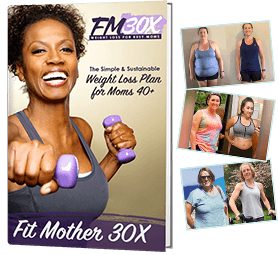
Learn More About FM30X

*Please know that weight loss results & health changes/improvements vary from individual to individual; you may not achieve similar results. Always consult with your doctor before making health decisions. This is not medical advice – simply very well-researched info on healthy eating for women.

